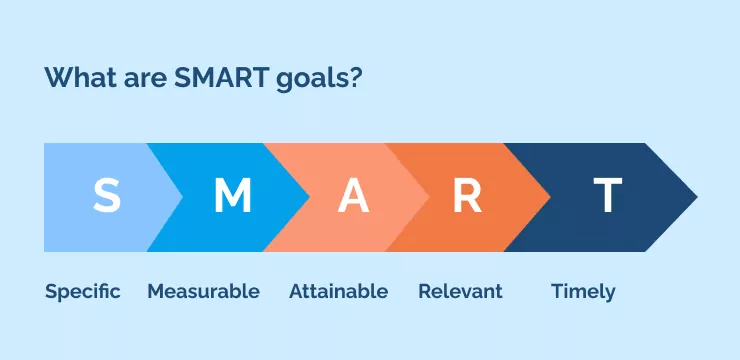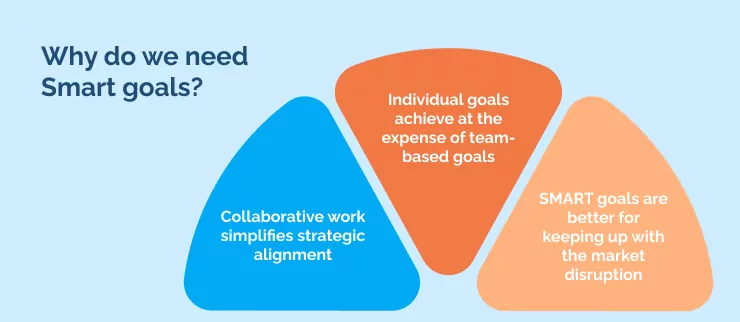
When you have a personal dream, how do you plan to achieve it?
Precisely like organizations do: you set small, achievable milestones and work toward achieving them as you measure progress.
LinkedIn research shows that when employee goals are aligned to employee and organizational needs, employee performance increases by up to 22%, making it worthy of investment.
SMART goals are crucial for effective change management. They provide a structured approach to setting achievable objectives in the face of new initiatives.
SMART goals examples will show your HR department the way the SMART system works to help your organization achieve its potential via the following topics:
- What are Smart goals?
- Why do we need Smart goals?
- What are the benefits of smart goals in 2023?
- 10 Smart goals examples for work
- How can you make smart goals examples for work for your organization?
What are SMART goals?

It is crucial to know what SMART goals are to optimize their use as you achieve your professional development goals.
SMART stands for specific, measurable, attainable, relevant, and timely, so let’s look at the significance of each letter.
Specific
For a goal to be practical, it must be specific and answer questions such as:
- What is the goal?
- Who is in charge of it?
- What are the necessary steps to achieve it?
One way to clarify your aim is by asking yourself these questions and recording the steps you must complete to achieve them as you measure your professional SMART goals progress.
Measurable
Although being specific about your goals is essential, making sure they are quantifiable is even more helpful.
Doing so means setting benchmarks that can be measured, making it easier to track your progress and determine when you have achieved your objective. To improve the effectiveness of this SMART goal, consider adding measurable benchmarks.
Attainable
At this stage of the process, conducting a reality check is crucial. Ensure you set achievable goals by considering if your team can accomplish each objective.
Relevant
You should consider the larger perspective when setting your goal. What is the reason for choosing this particular goal?
As one SMART goal example, knowing that an app plays a significant role in retaining customers, increasing the use of the app could significantly improve the company’s revenue goals. This example shows how critical relevant goals make it easy to measure success.
Timely
When you set time-bound goals, you are more likely to eliminate vague objectives and increase your chances of success with better time management skills.
If you prefer learning more visually, see the video below briefly explaining SMART goals and their uses.
To further explain SMART goals, check out the video below.
Understanding what SMART goals are allows you to understand the role they can play in the success of your organization.
Why do we need Smart goals?

Firstly, let’s ask why we need SMART goals to ensure your investment will bring ROI when implementing them across your organization.
Collaborative work simplifies strategic alignment
The nature of work is evolving rapidly with an increase in remote and hybrid work settings and a rise in the gig economy. Additionally, work is becoming more specialized in various domains.
According to a Gartner survey, 68% of leaders believe that employees require specialized competencies and experience to perform their work effectively. This scenario leads to more employees feeling disconnected from their organization’s objectives.

SMART goals can bring objectives together across departments so employees feel connected to the strategic direction of their colleagues and their organization.
Individual goals achieve at the expense of team-based goals
Although individual goal setting can promote personal progress, team or organizational SMART goal setting is more effective in bringing success to the organization.
Organizations need to know how SMART goal setting works to optimize their use for the organization’s benefit.
SMART goals are better for keeping up with the market disruption
HR leaders may believe that the nature of current job positions is rapidly shifting, requiring employees to develop new skills and adopt new methods of collaborating with others to facilitate changing business objectives.
As a result, most organizations still do annual goal-setting despite the fast and extensive changes happening in the business world. However, this practice fails to consider the dynamic nature of corporate strategies.
It’s vital for the goal-setting process also to evolve as business needs and outcomes change over time, which SMART goal setting allows due to its flexibility over shorter periods.
What are the benefits of smart goals in 2023?

There are many benefits to using SMART goals in 2023, beginning with promoting a focus on specific goals across your organization.
Focus
SMART goals help coordinate cross-departmental focus on specific goals, uniting departments and strengthening your organizational culture as you boost leadership skills.
Although you may assume it is best to prioritize the process over the result, focusing on the desired outcome can be a valuable aspect of setting SMART goals.
By clearly understanding the results you hope to achieve, you can better track progress and identify areas where you can improve.
Remembering the end goal will help you persevere through difficult times and setbacks that may occur during the process. It serves as a reminder that the outcome will be worthwhile.
Innovation
Many people don’t usually set goals because they fear failure, but setting SMART goals can help. SMART goals are specific, measurable, and attainable, assisting the employees to stay focused and accountable.
They also encourage staff to leave their comfort zone and eliminate excuses about achieving their professional desires for digital innovation.
Well-being
When you implement SMART goals, your staff’s well-being increases as they feel more direction and structure within their workflows. Doing so creates a healthier culture for staff as you improve customer satisfaction and employee experience.
Measuring success
Setting SMART goals is essential to determine when you have finished a project, preventing unnecessary delay and burnout and improving employee retention.
By using SMART goals, you can quickly identify what constitutes success and keep track of your progress toward achieving it.
10 Smart goals examples for work
The best way to understand the importance of Smart goals and how they work is by looking at examples of Smart goals for work in practice.
Each SMART goal example applies to any industry, and it’s helpful to note these goals communicate the need clearly, and all contain measurables, usually shown in percentages. These factors make it easy for an organization to achieve these Smart goals.
- Increase customer satisfaction by 15% by the end of the current quarter.
- Achieve a 30% reduction in overhead costs by the end of the year.
- Achieve 15,000 website visitors per month by the end of the next quarter.
- Increase employee engagement by 25% by the end of the year.
- Create a social media presence with 20,000 followers by the end of the quarter.
- Implement a system that improves operational efficiency by 10% by the second quarter.
- Increase customer acquisition by 25% by the end of the year.
- Reduce downtime by 5% by the end of the year.
- Achieve a digital adoption rate of 50% in the first year of a digital transformation using a DAP (digital adoption platform).
- Improve employee retention by 15% over 12 months.
These are examples of practical SMART goals, but you can tailor them to your organization’s needs. Communicating these goals regularly and clearly to employees is also core to implementing and achieving them successfully within the given time frame.
How can you build Smart goals for your organization?
Setting SMART Goals – How To Properly Set a Goal (animated)
Setting and achieving goals can be challenging. It’s important first to assess your current starting point. Then, identify and overcome any obstacles preventing you from reaching your goal. Additionally, consider exploring alternative paths to achieving success.
To achieve your desired outcome, you must choose the best strategic approach. Setting a goal is not enough; creating a strategy to attain that goal is crucial. In the process of developing a plan, you may gain a better understanding of what the actual goal should be.
Here are some helpful best practices for determining and developing goals, regardless of where you begin.
Focus on Important Outputs
To improve your team, department, and organization, you should focus on the outputs tied to financials, customers, processes, projects, or people. Whatever you do or create should aim to improve these critical outputs.
Baseline the Present
It is crucial to have an objective understanding of your current performance to set an effective goal.
For example, if you aim to complete a digital adoption project in three years, you should know your current completion time for a similar project. Goals represent the progress relative to your current status towards a future target.
Establishing a baseline is crucial for measuring progress toward a goal.
Create SMART Goals
To develop practical goals, use the SMART criteria. A quick way to apply SMART Goals is by asking these questions:
Specific
- What are we trying to achieve with this goal?
- Will all staff easily understand this goal?
- Is this goal too specific, or is it specific enough?
Measurable
- How will we know when we have achieved our goal?
Attainable
- What initiatives and plans do we need to accomplish this goal?
- Is this goal practical? Do we have a 60-80%+ chance of achieving it?
- Do we have the resources we need to achieve it?
Relevant
- Is this goal essential for us right now? Why?
- Does this goal reflect our mission, vision, and values?
Time-Bound
- What deadline will we use to achieve this goal?
- Is this a reasonable deadline?
Building and achieving your own SMART goals following the above guidelines can be an effective way of succeeding in all your business efforts and gaining a competitive edge against your peers.
Make Smart goals manageable to ensure success
Assigning specific tasks to individual team members while providing managerial oversight will help foster a secure environment for everyone to create their own SMART goals based on the objectives in the strategy-planning meeting for professional success.
Above all else, the goals you set must be manageable so that you can be successful. So start tracking your progress today and make SMART Goals part of your organizational culture today.
Tristan Ovington
Tristan Ovington is a professional senior writer and journalist, specializing in providing expert insights on various topics such as digital adoption, digital transformation, change management, and Cloud apps. He delivers his knowledge through accessible online content that is data-driven and presented in a friendly tone, making it easy for readers to understand and implement.



